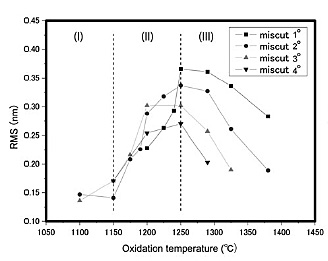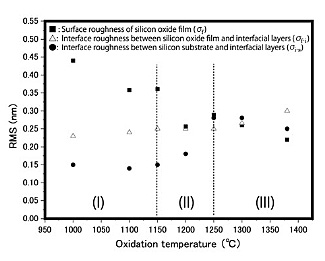Materials Science Laboratory, *Physical Science Laboratory
The SiO2/Si(001) has been one of the most important interfaces in silicon semiconductors and related silicon nanotechnologies. Due to its significance, therefore, much works have been done to understand the roughening mechanism of silicon oxidation not only on surface [1], but also at interface [2]. In this work, morphological evolution at the interface between the Si(001) substrate and the thermal SiO2 film grown at the oxidation temperature between 1000 and 1380ºC in a dilute oxygen/Ar atmosphere were systematically studied by atomic force microscopy (AFM) and synchrotron radiation X-ray reflectivity (XRR) measurements as a function of oxidation temperature and time, and miscut angle of the substrates. The AFM results show that thermal oxidation causes interface roughening with forming step-terrace structures (Region II in Fig. 1) between 1150-1250ºC and then smoothened during the thermal oxidation above 1250ºC (Region III in Fig. 1) independent of miscut angles below 4 deg. The interface roughening and smoothening possibly relates to the temperatures of which determine the viscosity of the growing SiO2 film. The XRR measurements on the as-grown silicon oxide films support the presence of the temperature dependences. As seen in Fig. 2, σi-s is constant in region (I), but it becomes extremely rough from Tox = 1150ºC with the roughness (RMS) reaching a maximum at Tox = 1250oC in region (II). It then gradually becomes smaller in region (III), in accordance with the AFM results in Fig. 1. The temperature dependence of interface and surface roughening in Fig. 2 indicates that there is an apparent temperature dependent mechanism of how the strain induced by oxidation relives at the growing interface between Si and silicon oxide film and in the whole region of silicon oxide films.
[1] Fundamental Aspects of Silicon Oxidation, edited by Y. J. Chabal (Springer, 2001).
[2] H. Omi, H. Kageshima, and M. Uematsu, Phys. Rev. Lett. 97 (2006) 01602.
[3] H. Omi, H. Kageshima, T. Kawamura, M. Uematsu, Y.Kobayashi, S. Fujikawa,
Y. Tsusaka, Y. Kagoshima, and J. Matsui, Phys. Rev. B. 79 (2009) 245319.
 |
 |
|||||
|
|